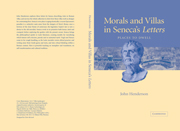Book contents
- Frontmatter
- Contents
- Acknowledgements
- Introduction
- 1 Twelve steps to haven
- 2 Dropping in (it) at SENECA'S
- 3 You can get used to anything
- 4 The long and winding mode
- 5 Booking us in
- 6 Now and then; here and there: at SCIPIO'S
- 7 Bound for VATIA'S
- 8 Knocking the self: genuflexion, villafication, VATIA'S
- 9 The world of the bath-house: SCIPIO'S
- 10 The appliance of science: SCIPIO'S
- 11 Shafts of light: transplantation and transfiguration
- 12 Still olive, still SCIPIO'S
- Appendix 1 Here to stay Places and persons named in the Epistulae Morales
- Appendix 2 From: Letter 86 To: A Dying Light in Corduba
- Bibliography
- Indexes
9 - The world of the bath-house: SCIPIO'S
Scipio in Letter 86; with: Horace's common scents
Published online by Cambridge University Press: 22 September 2009
- Frontmatter
- Contents
- Acknowledgements
- Introduction
- 1 Twelve steps to haven
- 2 Dropping in (it) at SENECA'S
- 3 You can get used to anything
- 4 The long and winding mode
- 5 Booking us in
- 6 Now and then; here and there: at SCIPIO'S
- 7 Bound for VATIA'S
- 8 Knocking the self: genuflexion, villafication, VATIA'S
- 9 The world of the bath-house: SCIPIO'S
- 10 The appliance of science: SCIPIO'S
- 11 Shafts of light: transplantation and transfiguration
- 12 Still olive, still SCIPIO'S
- Appendix 1 Here to stay Places and persons named in the Epistulae Morales
- Appendix 2 From: Letter 86 To: A Dying Light in Corduba
- Bibliography
- Indexes
Summary
The visit to scipio's is an inside job. Narrative breaks through the epistolary manner, to take us inside the chosen ‘historical exemplum’ for a whole rounded composition. In the next Letter, ‘Cato’ will shrink back into the usual parameters, as a momentary concretization of the argument (87.9–10). Whereas we were safely guided past the exterior of vatia's Siren seduction, to shake us from comatose lethargy, we begin here, as we mean to go on, right there:
In ipsa Scipionis Africani uilla
Inside the actual manor of the Scipio dubbed Conqueror of Africa.
This is a place to be still, to lie there and think, to let this shrine infuse, implant, its spiritual message into our own inwards, into us (iacens). Our whereabouts? We are now in the grave; that is all the location we get and all we need: the ambience permeates this writing with holy miasma, as religious atmosphere pens today's unorthodox praeparatio mortis (adoratis manibus eius et ara). Let us pray – for once the Letters take a positive turn, trusting to the legacy of (Roman Republican) Tradition for solid bedrock. For all that Seneca will shoot off shafts of morally energizing satire at the decadence of (Roman Imperial) Modernism. This is no place for the mannered self-ironization of our visit to seneca's gardening, not the moment to run into superannuated staff and wallow in senile sentimentality.
- Type
- Chapter
- Information
- Morals and Villas in Seneca's LettersPlaces to Dwell, pp. 93 - 118Publisher: Cambridge University PressPrint publication year: 2004



